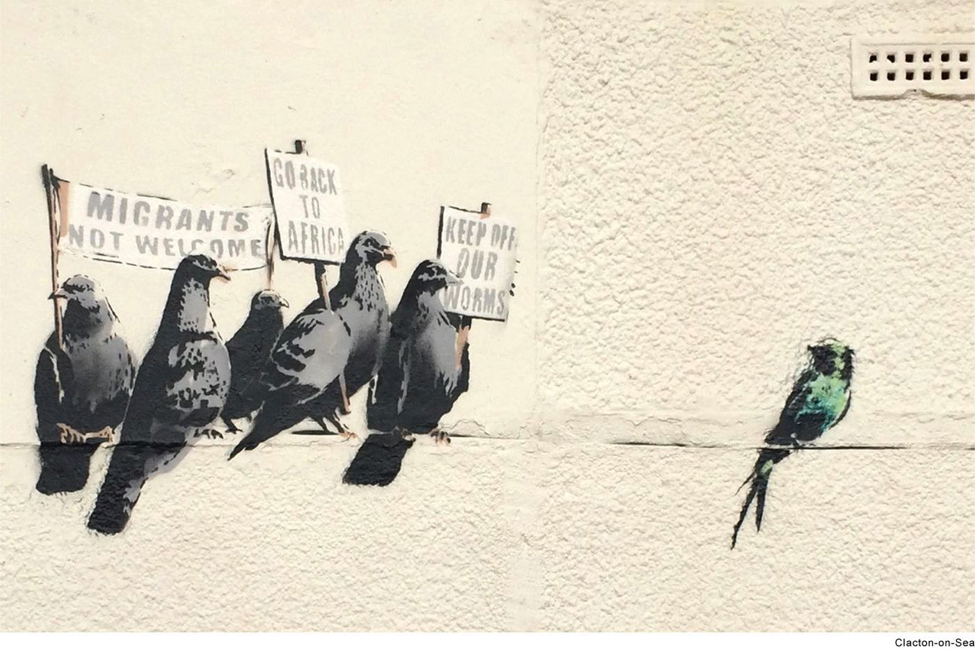One can find nuance in anything no matter how straightforward, like New York City’s laws regarding graffiti. A good example of a nuance in the legality of graffiti comes with Banksy’s work. Although illegal, many local governments, including that of New York City, encourage Banksy to create his art in their cities. For example, he once created a piece on immigration that was taken down by the local government of Clacton-on-Sea due to some interpreting it as racist, but in a statement later said, “We would obviously welcome an appropriate Banksy original on any of our seafronts and would be delighted if he returned in the future.” The town paradoxically invited Banksy to come back and commit a crime with this release. Most cities will not remove works by Banksy and will go even as far as to restore his pieces that get defaced or destroyed, which all shows that Banksy’s works are special cases when it comes to legality and street art. The legal differentiator between graffiti and street art is permission, which I believe is implied for Banksy allowing him to do what he does unbothered by law enforcement. The New York City government states that “No person shall write, paint or draw any inscription, figure or mark of any type on any public or private building or other structure or any other real or personal property owned… unless the express permission of the owner or operator of the property has been obtained” (New York City Graffiti Laws). Although this law seems clear, odd circumstances can lead to serious debate surrounding the legality of street art.

(nytimes.com)
This was the case with the 5Pointz curator’s battle against building owner, Jerry Wolkoff, to keep the murals protected in a trailblazing court case for street artists. The story of the 5Pointz murals started with the artist Jonathan Cohen in the ‘90s. He asked for permission from the owner to paint on the walls of their largely unused artist studios, and as time went by more artists from all over began to add to the collection of works that would soon be known as 5Pointz. The owners of the property were granted permission in 2013 to demolish the buildings and reconstruct new high-rise apartments; however, obviously, this would also include having to tear down the murals associated with the buildings. But if the art is the curators’ property, do the building owners still have the right to tear the building down? The artists and their legal team cited the Visual Artists Rights Act (VARA), which protects an artist’s work that does not belong to them, after the owners whitewashed the murals in an effort to remove anything that could grant the site landmark status to terminate the legal battles trying to keep the murals standing. VARA only protects a work of visual art, defined as “a painting, drawing, print, or sculpture, existing in a single copy, in a limited edition of 200 copies or fewer that are signed and consecutively numbered by the author… and bear the signature or other identifying mark of the author.” The whitewashed murals were granted protection under VARA by a jury in November of last year, the first time this had happened with graffiti. The artists were recently given $6.7 million in reparations for the destruction of their works. The cases of 5Pointz and Banksy are just two examples of how complicated the legality of street art can be no matter how well defined the laws are.


(artsy.net)
Works Cited
Feuer, Alan. “Graffiti Artists Awarded $6.7 Million for Destroyed 5Pointz Murals.” The New York Times, The New York Times, 13 Feb. 2018
Horne, Alex. “Why Is Banksy the Only Person Allowed to Vandalize Britain’s Walls?” Vice, Vice, 3 Oct. 2014.
Sewell, Dayrel. “Graffiti: Legal or Illegal?” Law Firm of Dayrel Sewell, Pllc, Litigation, Intellectual Property, Real Estate!, 25 Aug. 2017
United States. New York City Mayor. City and State Anti-Graffiti Legislation. Nyc.gov, n.d. Web.